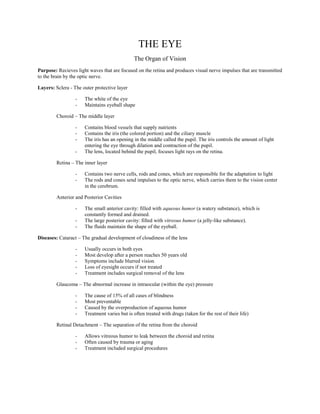
Mus presentation project
- 1. THE EYE The Organ of Vision Purpose: Recieves light waves that are focused on the retina and produces visual nerve impulses that are transmitted to the brain by the optic nerve. Layers: Sclera - The outer protective layer - The white of the eye - Maintains eyeball shape Choroid – The middle layer - Contains blood vessels that supply nutrients - Contains the iris (the colored portion) and the ciliary muscle - The iris has an opening in the middle called the pupil. The iris controls the amount of light entering the eye through dilation and contraction of the pupil. - The lens, located behind the pupil, focuses light rays on the retina. Retina – The inner layer - Contains two nerve cells, rods and cones, which are responsible for the adaptation to light - The rods and cones send impulses to the optic nerve, which carries them to the vision center in the cerebrum. Anterior and Posterior Cavities - The small anterior cavity: filled with aqueous humor (a watery substance), which is constantly formed and drained. - The large posterior cavity: filled with vitreous humor (a jelly-like substance). - The fluids maintain the shape of the eyeball. Diseases: Cataract – The gradual development of cloudiness of the lens - Usually occurs in both eyes - Most develop after a person reaches 50 years old - Symptoms include blurred vision - Loss of eyesight occurs if not treated - Treatment includes surgical removal of the lens Glaucoma – The abnormal increase in intraocular (within the eye) pressure - The cause of 15% of all cases of blindness - Most preventable - Caused by the overproduction of aqueous humor - Treatment varies but is often treated with drugs (taken for the rest of their life) Retinal Detachment – The separation of the retina from the choroid - Allows vitreous humor to leak between the choroid and retina - Often caused by trauma or aging - Treatment included surgical procedures
- 2. THE EAR The Organ of Hearing and Balance Parts: TheOuter Ear - Pinna: the appendage on the outside of the head - Auditory Canal: the tube that leads from the outer ear to the middle ear, through which sound waves pass The Middle Ear - Tympanic Membrane (eardrum): separates the outer ear from the middle ear o The eardrum contains three small bones: the malleus, incus, and stapes. These bones transfer vibrations of the eardrum to the inner ear. - Eustachian Tube: equalizes pressure on both sides of the tympanic membrane The Inner Ear (or Labyrinth) - Cochlea: an organ shaped like a snail, with receptors for hearing - Semicircular Canals: maintains balance and equilibrium Diseases: Tinnitus – A symptom in most disorders of the ear - A ringing, buzzing, or roaring noise in the ears - May be caused by muscle spasm or an abnormality in blood vessels - Common causes include chronic infection, head injury, prolonged exposure to loud noise, hypertension, and cardiovascular disease - Also caused by drugs that are ototoxic, such as aspirin - Treatment includes masking ear noises by providing soft background music